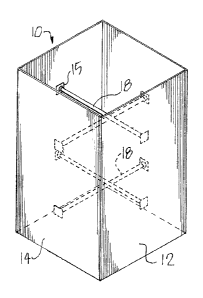Some of the information on this Web page has been provided by external sources. The Government of Canada is not responsible for the accuracy, reliability or currency of the information supplied by external sources. Users wishing to rely upon this information should consult directly with the source of the information. Content provided by external sources is not subject to official languages, privacy and accessibility requirements.
Any discrepancies in the text and image of the Claims and Abstract are due to differing posting times. Text of the Claims and Abstract are posted:
| (12) Patent: | (11) CA 2776772 |
|---|---|
| (54) English Title: | DUCTWORK STIFFENER |
| (54) French Title: | RAIDISSEUR DE GAINE |
| Status: | Granted |
| (51) International Patent Classification (IPC): |
|
|---|---|
| (72) Inventors : |
|
| (73) Owners : |
|
| (71) Applicants : |
|
| (74) Agent: | MOFFAT & CO. |
| (74) Associate agent: | |
| (45) Issued: | 2014-10-28 |
| (22) Filed Date: | 2012-05-14 |
| (41) Open to Public Inspection: | 2013-03-26 |
| Examination requested: | 2012-05-14 |
| Availability of licence: | N/A |
| (25) Language of filing: | English |
| Patent Cooperation Treaty (PCT): | No |
|---|
| (30) Application Priority Data: | ||||||
|---|---|---|---|---|---|---|
|
The ductwork utilized in heating and air conditioning systems is provided with internal crossbars secured to the sides of the duct to prevent inward or outward flexing in response to a pressure differential that could otherwise cause collapse of the sides, either inward or outward, and failure of system. The crossbars are spaced along the run of the duct with the opposed ends of each crossbar received within and secured to corresponding sockets mounted internally on opposite walls of the duct.
La gaine utilisée dans des systèmes de chauffage et de conditionnement dair est dotée de barres transversales internes fixées aux parois de la gaine pour empêcher la flexion vers lintérieur ou lextérieur en réaction à une pression différentielle qui pourrait autrement faire seffondrer les parois, soit vers lintérieur, soit vers lextérieur, et causer léchec du système. Les barres transversales sont espacées le long de la gaine et les extrémités opposées de chaque barre transversale sont accueillies dans les cavités correspondantes, en plus dy être fixées, qui sont disposées de façon interne sur les parois opposées de la gaine.
Note: Claims are shown in the official language in which they were submitted.
Note: Descriptions are shown in the official language in which they were submitted.

For a clearer understanding of the status of the application/patent presented on this page, the site Disclaimer , as well as the definitions for Patent , Administrative Status , Maintenance Fee and Payment History should be consulted.
| Title | Date |
|---|---|
| Forecasted Issue Date | 2014-10-28 |
| (22) Filed | 2012-05-14 |
| Examination Requested | 2012-05-14 |
| (41) Open to Public Inspection | 2013-03-26 |
| (45) Issued | 2014-10-28 |
There is no abandonment history.
Last Payment of $125.00 was received on 2024-05-10
Upcoming maintenance fee amounts
| Description | Date | Amount |
|---|---|---|
| Next Payment if standard fee | 2025-05-14 | $347.00 |
| Next Payment if small entity fee | 2025-05-14 | $125.00 |
Note : If the full payment has not been received on or before the date indicated, a further fee may be required which may be one of the following
Patent fees are adjusted on the 1st of January every year. The amounts above are the current amounts if received by December 31 of the current year.
Please refer to the CIPO
Patent Fees
web page to see all current fee amounts.
| Fee Type | Anniversary Year | Due Date | Amount Paid | Paid Date |
|---|---|---|---|---|
| Request for Examination | $400.00 | 2012-05-14 | ||
| Application Fee | $200.00 | 2012-05-14 | ||
| Maintenance Fee - Application - New Act | 2 | 2014-05-14 | $50.00 | 2014-05-13 |
| Final Fee | $150.00 | 2014-08-15 | ||
| Maintenance Fee - Patent - New Act | 3 | 2015-05-14 | $50.00 | 2015-05-13 |
| Maintenance Fee - Patent - New Act | 4 | 2016-05-16 | $50.00 | 2016-05-12 |
| Maintenance Fee - Patent - New Act | 5 | 2017-05-15 | $100.00 | 2017-05-12 |
| Maintenance Fee - Patent - New Act | 6 | 2018-05-14 | $100.00 | 2018-03-14 |
| Maintenance Fee - Patent - New Act | 7 | 2019-05-14 | $100.00 | 2019-03-14 |
| Maintenance Fee - Patent - New Act | 8 | 2020-05-14 | $100.00 | 2020-03-04 |
| Maintenance Fee - Patent - New Act | 9 | 2021-05-14 | $100.00 | 2021-04-12 |
| Maintenance Fee - Patent - New Act | 10 | 2022-05-16 | $125.00 | 2022-04-20 |
| Maintenance Fee - Patent - New Act | 11 | 2023-05-15 | $125.00 | 2023-03-13 |
| Maintenance Fee - Patent - New Act | 12 | 2024-05-14 | $125.00 | 2024-05-10 |
Note: Records showing the ownership history in alphabetical order.
| Current Owners on Record |
|---|
| MURCHIE, PHILLIP W. |
| Past Owners on Record |
|---|
| None |